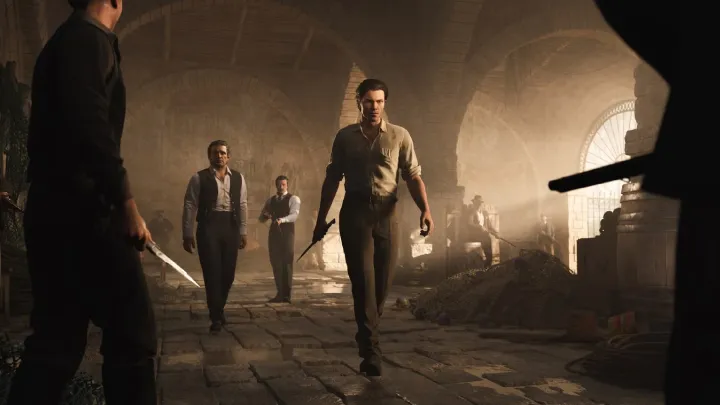Introduction
Look Outside is a narrative-driven exploration game that immerses players in a world where the environment itself tells the story. Unlike traditional games where dialogue or cutscenes carry the narrative, this title uses environmental details—abandoned objects, changing weather, evolving landscapes, and subtle visual cues—to shape the player’s understanding of the world. While beautiful and immersive, this method of storytelling presents both strengths and challenges. In this article, we will examine the core issue of environmental storytelling in Look Outside, diving into its impact on player immersion, pacing, and interpretation.
The First Encounter – Discovering a Silent World

At the very start of Look Outside, players are not given much instruction. Instead of tutorials filled with dialogue, the world itself acts as the teacher. The silence of the abandoned streets, the scattered belongings in empty houses, and the sound of wind across desolate fields create an atmosphere of mystery.
This approach forces players to interpret meaning from their surroundings. For many, it creates an instant connection, as though they are detectives piecing together the fate of this world. However, some players find the lack of direction overwhelming, unsure of what they are supposed to notice or interpret.
Environmental Clues as Storytelling Devices
The heart of the game lies in the environmental details. Each object or structure is carefully placed to reveal fragments of the narrative. A broken swing set, a journal half-buried under leaves, or even the shifting of sunlight across a ruined building contributes to the story.
H3: Types of Environmental Clues
- Objects: abandoned items such as toys, photographs, and tools hint at the lives once lived.
- Architecture: the decay of homes, offices, and factories reflects the passage of time and the collapse of society.
- Nature: overgrown vegetation or animal tracks reveal how the natural world has adapted in humanity’s absence.
Players who slow down and observe find themselves rewarded with a deeper understanding of the world.
The Struggle of Pacing – When Storytelling Feels Too Slow
One major challenge with environmental storytelling in Look Outside is pacing. Since there are no direct narrative prompts, the game’s story unfolds slowly, depending on how players explore.
For dedicated players who enjoy methodical observation, this creates a rewarding experience. But for those used to fast-paced narratives, the lack of explicit direction can feel frustrating. Some even abandon the game early, claiming “nothing is happening,” when in reality, the story is happening around them—it just requires patience to notice.
The Role of Weather and Atmosphere
Weather is not just a visual element in Look Outside; it is a storytelling device. A sudden storm might symbolize turmoil, fog can represent uncertainty, and bright sunlight may signal fleeting hope.
H4: Emotional Connection through Weather
- Rain enhances the loneliness of abandoned spaces.
- Snow conveys stillness and the passage of forgotten time.
- Shifting light patterns mirror emotional highs and lows.
This dynamic system helps players emotionally sync with the world, making the environment feel alive and responsive to the narrative.
Player Interpretation – A Story Without Words
Look Outside thrives on ambiguity. The absence of dialogue and text leaves the story open to interpretation, which both empowers and frustrates players.
Some see the abandoned world as a metaphor for climate change. Others interpret it as a post-apocalyptic tale of human disappearance. This openness makes the game endlessly discussable but also divisive—there is no single “correct” interpretation.
The Challenge of Accessibility in Storytelling
While environmental storytelling is immersive, it creates accessibility issues. Not every player can easily interpret subtle visual cues. Those with limited time, different cultural contexts, or less experience with exploration games may miss essential clues.
H3: Examples of Accessibility Barriers
- Non-linear exploration leads to missed key details.
- Over-reliance on visual cues excludes players with visual impairments.
- Cultural references may be lost on international players.
This shows the balance developers must strike between artistic vision and accessibility.
Comparing Environmental Storytelling with Traditional Methods
To understand the uniqueness of Look Outside, it is useful to compare it with narrative-driven games that rely on direct dialogue or cutscenes.

Strengths of Environmental Storytelling
- Allows freedom of discovery.
- Increases immersion through subtlety.
- Encourages replayability with hidden details.
Weaknesses of Environmental Storytelling
- Can feel slow and confusing.
- Lacks the emotional clarity of dialogue-driven games.
- Risk of misinterpretation.
This comparison highlights the bold but risky design choices of Look Outside.
Emotional Impact – The Silence Speaks Loudly
One of the greatest achievements of Look Outside is its ability to evoke emotion without words. Players often report feelings of loneliness, nostalgia, or unease simply by walking through its landscapes.
The silence of the world is not emptiness—it is filled with meaning. The quiet becomes a character itself, forcing players to confront emotions they might avoid in dialogue-heavy games.
Long-Term Player Engagement
A common criticism of Look Outside is its replayability. Once players have uncovered environmental clues and formed their interpretation, some find little reason to return. However, others argue the ambiguity of the story invites multiple playthroughs, each revealing something new based on different perspectives.
This tension reflects the central issue of environmental storytelling: its strength in depth and subtlety can also be its weakness in long-term retention.
Conclusion – The Power and Limits of Environmental Storytelling
Look Outside exemplifies the potential and challenges of environmental storytelling. By relying on atmosphere, weather, and environmental clues, it creates an immersive, emotional world that encourages players to slow down and pay attention. Yet, this same strength risks alienating players who prefer direct narratives.
The game is not for everyone, but for those willing to embrace silence and ambiguity, it offers one of the most powerful explorations of how environments can tell stories without a single spoken word.

















